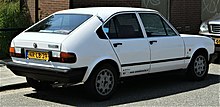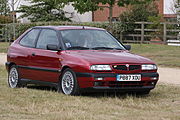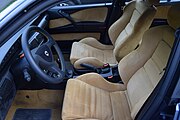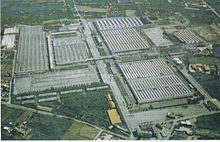Lancia Delta (836)
| Lancia | |
|---|---|
|
Lancia Delta HF 2.0 Turbo LS (1994)
|
|
| Delta (Tipo 836) | |
| Production period: | 1993-1999 |
| Class : | Compact class |
| Body versions : | Station wagon |
| Engines: |
Otto engines : 1.6–2.0 liters (55–142 kW) Diesel engine : 2.0 liters (66 kW) |
| Length: | 4011 mm |
| Broad: | 1759 mm |
| Height: | 1430 mm |
| Wheelbase : | 2450 mm |
| Empty weight : | 1130-1330 kg |
| Previous model | Delta (831) |
| successor | Delta (844) |
The Lancia Delta of the 836 series (also: Delta II and Nuova Delta , proper spelling : Lancia δ ) is a compact sedan of the Italian car brand Lancia , which was produced from 1993 to 1999. The model replaced the first generation of the Delta , which was introduced in 1979 and was very successful in motorsport . The three- and five-door as a hatchback car offered is based on Fiat Tipo-Due - platform , and is one with the Fiat Tipo and the Alfa Romeo 145 /146 related.
History of origin
The Lancia brand, which has been part of the Fiat Group since 1969, introduced the first version of the Delta compact car (Tipo 831) in 1979 . It had the technology of the Fiat Ritmo and an angular body designed by Giorgio Giugiaro . Three years later, the notchback version Prisma appeared with comparable technology.
In 1988, Fiat introduced the Tipo Due platform, under the significant responsibility of manager Vittorio Ghidella , which in the following decade formed the basis of almost all of the group's compact models. The first Tipo Due offshoot was the five-door Fiat Tipo, the second the notchback sedan Lancia Dedra , presented in 1989 , which replaced the previous Prisma. Although the modern Dedra quickly established itself and brought the company profits, Lancia initially did not push an estate car on the same basis. Instead, the first series of the Delta remained in the program until 1993 - in some special versions even until 1994. It continued to sell well, not least because of the advertising effectiveness of numerous rally successes of the Integrale and its variants.
The development of the second Delta generation did not begin until 1988, when the four-door Dedra was already ready for series production. Fiat's Tipo Due platform was used as the basis . The car made its debut in the spring of 1993 after four and a half years of development. The comparatively long development period meant that the Delta had some safety features right from the start that the older Fiat Tipo had only received with a delay. During its almost seven years of production, the Nuova Delta was only slightly changed. Over the years, a second body variant and various engines were added. At the end of the decade, the delta, with its technology dating back to the 1980s, was considered "out of date"; the sales figures have recently decreased significantly.
Production ended in late summer 1999. The last vehicles were sold until 2000. Overall, the Nuova Delta was far less successful than the Dedra with a notchback body: By 1999 Lancia had built more than three times as many Dedras as Deltas. After its production cessation, the Nuova Delta did not get a successor immediately. According to Lancia's conception, the Lybra notchback sedan , which also replaced the Dedra, took its position in the model range for a few years . It was not until 2008 that Lancia introduced the third generation of the Delta with the internally known Tipo 844 station wagon .
Model description
Body and interior
The Nuova Delta has a self-supporting body made of sheet steel. From the start of production, some safety-relevant features such as a stiffened body and side impact protection in the doors were part of the standard equipment that the Fiat Tipo had lacked in the first years of construction.
The shape of the Nuova Delta , initially only available as a five-door and from 1995 also as a three-door, was designed by the Turin-based I.DE.A Institute under the direction of Ercole Spada in collaboration with the Centro Stile Lancia . From a stylistic point of view, the structure is considered to be a revival of the Alfa Romeo Alfasud , which was still highly regarded in Italy 10 years after its production was discontinued. In particular, the high rear end with a short overhang, the roofline tapering off at a slight incline and the plastic panels in the C-pillar, which stylized the door profile of the Alfasud, are understood as design references. On the other hand, the Delta 836 has many parts in common with contemporary Lancia models. It shares the doors of the five-door version, the windshield and the side windows with the Lancia Dedra, which was also designed by I.DE.A. The front section is more inclined than on the Dedra. The Delta has independent broadband headlights from Bosch ; between them is the radiator opening, which is set in a stylized Lancia coat of arms. The basic versions have a smooth rear end, while the more powerfully motorized models are factory-fitted with a spoiler painted in the vehicle color underneath the rear window. Its profile shows the lines of a bead at the rear end of the second series of the Alfasud (1980–1983). The horizontally arranged taillights were also installed in the high-priced Kappa Coupé from 1997 onwards . A special design feature of individual versions are the widened front fenders. They can be found on three and five-door versions of the top model Delta HF as well as on all Deltas with a diesel engine.
While numerous switches and controls in the interior come from the Fiat range, the dashboard of the Delta has no counterpart in any other member of the Tipo Due family. It is curved over the entire width of the interior. The instruments are arranged horizontally next to each other. The seat covers of the simpler models are made of fabric; Covers made of Alcantara or of fabric-Alcantara or leather-Alcantara combinations were available for an extra charge - in some cases as standard for the higher-quality variants . All Delta variants have a split rear seat backrest that can be folded down.
Engines and power transmission
The Delta was offered with various four-cylinder engines from the Fiat range, most of which were gasoline engines.
All gasoline engines have electronic fuel injection and were available with different power levels during the production period.
- The base engine was two offshoots of the Fiat 128 SOHC engine with 1.4 and 1.6 liter displacement. The 1.4-liter version, which has an output of 55 kW (75 hp), was only offered for a short time in selected markets with a view to the local tax laws. It was not available in Germany. Instead, the 1.6-liter version was the entry-level engine in most markets. They were available with either eight or 16 valves. The power range extends from 55 kW (75 PS) to 76 kW (103 PS).
- The middle engine was a 1.8 liter variant of Fiat's Pratola Serra construction. Here, too, at the beginning, alternative versions with eight and 16 valves were available. The engine output is 66 kW (90 PS) to 96 kW (131 PS).
- The top models are powered by 2.0 liter versions of the Fiat Twin-Cam engine designed by Aurelio Lampredi with two overhead camshafts , available with and without turbocharging. The most powerful versions with up to 142 kW (193 hp) had the additional designation HF.
In addition, from the second year of production of the Delta, a 2.0 liter turbodiesel with four cylinders was available, which sold particularly well in southern Europe.
| Engines of the Lancia Delta 836 | ||||
|---|---|---|---|---|
| model | cylinder | Displacement | power | construction time |
| Gasoline engines | ||||
| 1.4 ie | 4th | 1372 cc | 55 kW (75 PS) | 1993-1995 |
| 1.6 ie | 1581 cc | 55 kW (75 PS) | 03 / 1993-08 / 1999 | |
| 1.6 ie 16V | 66 kW (90 PS) | |||
| 76 kW (103 PS) | 03 / 1996-08 / 1999 | |||
| 1.8 ie | 1756 cc | 66 kW (90 PS) | 07 / 1994-02 / 1996 | |
| 1.8 ie 16V | 1747 cc | 83 kW (113 hp) | 03 / 1996-08 / 1999 | |
| 96 kW (131 PS) | ||||
| 2.0 16V | 1995 cc | 102 kW (139 hp) | 03 / 1993-08 / 1999 | |
| 2.0 16V HF | 137 kW (186 hp) | 03 / 1993-02 / 1996 | ||
| 142 kW (193 hp) | 06 / 1996-08 / 1999 | |||
| Diesel engine | ||||
| 1.9 TD | 4th | 1929 cc | 66 kW (90 PS) | 10 / 1994-08 / 1999 |
The power transmission takes over a manual five-speed gearbox without exception. Unlike the Dedra notchback version, an automatic transmission was not available for the entire duration of production.
landing gear
The Nuova Delta has all-round independent suspension . The front suspension consists of wishbones and MacPherson struts , plus a transverse stabilizer . At the rear there are trailing arms ( swing arms ), coil springs and a stabilizer bar. This structure is the same for all variants, only in the Delta HF with the most powerful motor some parts are reinforced. Almost all Delta versions have disc brakes at the front and rear as standard . Exceptions are the 1.4 variant and the 1.6 liter version with eight valves with drum brakes at the rear.
Facelift
1996
Lancia made a first revision of the Delta for the 1996 model year. Externally, these variants can be recognized primarily by the exterior mirrors and A-pillars, which, in contrast to the original Delta, are no longer painted black, but in the body color.
1998
In 1998 the body of the Delta was visually redesigned again. The tops of the bumpers, the side bumper strips and the plastic panels behind the rear doors and on the tailgate, which were previously black, are painted in the same color as the car on the models from the last two years. The taillights have a red base tone. The choice of seat upholstery has been streamlined for the five-door models; Complete Alcantara equipment, which was previously available in six different versions, was dropped in favor of standardized seat covers made from a combination of fabric and Alcantara.
Delta HPE
At the 1995 Geneva Motor Show , Lancia presented the three-door version of the Delta. It received the additional designation HPE (for High Performance Executive ) based on the combination coupé Beta HPE produced from 1975 to 1984 .
The HPE was available with all engines except for the 1.4-liter four-cylinder that were offered on the contemporary five-door Deltas. The front and rear of the Delta HPE are the same as those of the five-door Delta; On the other hand, the design on the sides of the car is independent. The doors are wider than the front doors of the five-door models. In contrast to them, all HPE also have rear fender flares. On the other hand, until 1998, only the particularly powerful HF and the HPE with diesel engine - like the five-door model - had exposed front fenders, while the basic version of the HPE was equipped with the standard five-door fenders. It was not until the last facelift in 1998 that all HPE variants were given front fenders regardless of their engine type.
Delta HF Turbo
As with the first Delta generation, the top model of the Nuova Delta bears the additional designation HF. It is equipped with a 2.0 liter inline four-cylinder engine with 16 valves and a turbocharger. The HF versions have an overboost that briefly increases the boost pressure of the turbocharger under full load, so that the torque increases by around 10%. The technical features also include a limited slip differential and electronically adjustable shock absorbers on the front wheels. Unlike the HF version of the old Delta 831, the new Delta HF Turbo was only available with front-wheel drive; All-wheel drive ("Integrale") was not offered, even if it was optionally available in the correspondingly motorized top version of the Dedra notchback sedan as well as in the Dedra station wagon.
First series (1993 to 1996)
The first HF series was produced from 1993 to February 1996. It is based on the five-door Delta. The front fender flares are a major external difference; the rear fenders, however, correspond to the other Delta versions. Only the HF had air inlets under the headlights and a lower front apron. It has a rear spoiler in body color as standard. In the first HF version, the engine has an output of 137 kW (186 hp). The car reaches a top speed of 225 km / h. From this version, a total of 3,155 vehicles were built in two and a half years.
Second series (1996 to 1999)
The second series of the Delta HF was introduced in 1996 and remained in the range until the Nuova Delta was discontinued in 1999. It was only available as a three-door model. The engine output rose to 142 kW (193 hp); otherwise the technology remained unchanged. Lancia also offered special models from time to time. In 1996 there was the Delta HPE EVO 500 with a sports package. It cost 4500 DM surcharge, was lowered and had, among other things, front and rear aprons, light metal rims and carbon panels in the interior. Lancia built a total of 2445 copies of the HPE version of the HF.
production
Unlike its predecessor, the Nuova Delta was not built in Lancia's own production facilities. While the Delta 831 and the first versions of the Dedra were still being made at the Lancia Chivasso plant near Turin , the Nuova Delta rolled off the assembly line in its first year of production at Alfa Romeo in Pomigliano d'Arco, southern Italy , before production moved to Fiat's Rivalta plant in Turin in 1994 was relocated.
From 1993 to 1999, all versions combined, 137,743 vehicles of the Lancia Delta 836 series; almost half of this was accounted for by the 1.6-liter version.
| Production numbers | ||
|---|---|---|
| Motorization | Five-door | Three-door HPE |
| 1.4 ie | 11,654 | |
| 1.6 ie and 1.6 ie 16V | 65,420 | 3,065 |
| 1.8 ie and 1.8 ie 16V | 16,185 | 1,909 |
| 2.0 16V | 4,339 | 1,825 |
| HF 2.0 turbo | 3,155 | 2445 |
| 2.0 turbo diesel | 16,487 | 11,259 |
Prices
When it was launched in Germany in spring 1993, the list price of the Delta with the weakest engine (1.6 ie) was 25,700 DM, the 1.8-liter version cost 30,800 DM. It was around 3000 DM more expensive than a comparable motorized one VW Golf and 4000 DM more expensive than a Fiat Tipo. The price for the top version HF 2.0 Turbo LS was 43,500 DM, about 1000 DM above the slightly weaker VW Golf VR6 . The correspondingly motorized top version of the four-door Lancia Dedra, which was also equipped with all-wheel drive, was 1000 euros cheaper than the Delta HF. The three-door HPE versions offered from 1995 were each about 1,000 DM cheaper than the five-door.
Tuning
The Augsburg tuner Holzer offered a performance-enhanced version of the five-door Delta HF 2.0 Turbo LS in 1994. With increased boost pressure and a new manifold between the cylinder head and the turbocharger, Holzer increased the engine's output from 186 hp to 236 hp. The car also received a sports suspension with components from Eibach . The conversion cost 4370 DM, which was almost a tenth of the list price for the standard original model. A German test report criticized the inharmonious performance characteristics and the "starting engine power in the medium speed range"; Overall, the tester described the Holzer Delta - alluding to the name of the tuner - as "uncouth".
literature
- Wim Oude Weernink: Lancia , Motorbuch Verlag, 1992, ISBN 3-613-01503-X
Web links
Remarks
- ↑ The Lancia Delta I is stylistically a scaled-down version of the Maserati Medici concept vehicle ; see Lange, Hans-Karl: Maserati. The other Italian sports car . Vienna 1993. ISBN 3-552-05102-3 .
Individual evidence
- ↑ Wim Oude Weernink: Lancia , Motorbuchverlag, 1992, ISBN 3-613-01503-X , S. 376th
- ↑ a b Auto Catalog No. 42 (1998/99), p. 93.
- ↑ Alessandro Sannia: Enciclopedia dei carrozzieri italiani , Società Editrice Il Cammello, 2017, ISBN 978-8896796412 , p. 293.
- ^ Daniele Cornil: Centro Stile Lancia , Automobilia, 2001, ISBN 978-8879601214 .
- ^ Massimiliano Serra, Saverio Villa: Benvenuti al Sud. Alfa Romeo Alfasud e derivatives . Routoclassiche Youngtimer No. 20 (July / August 2021), p. 26.
- ↑ Berliner Kurier 1996, June 23, p. 18.
- ↑ Technical data and production figures for the Lancia Delta 836 (accessed on September 10, 2021)
- ↑ Auto Catalog No. 37 (1993/94), p. 320 (Lancia) and 329 (Volkswagen).
- ↑ Auto Catalog No. 42 (1998/99), p. 301.
- ↑ Michl Koch: Yellow fever . Short test Holzer-Lancia Delta HF Turbo LS, Auto Motor und Sport, issue 16/1994, p. 40.
| Timeline of the Lancia and Autobianchi models since 1945 | |||||||||||||||||||||||||||||||||||||||||||||||||||||||||||||||||||||||||||||
|---|---|---|---|---|---|---|---|---|---|---|---|---|---|---|---|---|---|---|---|---|---|---|---|---|---|---|---|---|---|---|---|---|---|---|---|---|---|---|---|---|---|---|---|---|---|---|---|---|---|---|---|---|---|---|---|---|---|---|---|---|---|---|---|---|---|---|---|---|---|---|---|---|---|---|---|---|---|
| Type | Lancia, independent until 1969 | Bought by Fiat in 1969, Fiat number range since then | |||||||||||||||||||||||||||||||||||||||||||||||||||||||||||||||||||||||||||
| Autobianchi, JV between Bianchi, Fiat and Pirelli | from 1967 100% part of the Fiat group | abroad as Lancia, in Italy as Autobianchi | |||||||||||||||||||||||||||||||||||||||||||||||||||||||||||||||||||||||||||
| 1940s | 1950s | 1960s | 1970s | 1980s | 1990s | 2000s | 2010s | 2020s | |||||||||||||||||||||||||||||||||||||||||||||||||||||||||||||||||||||
| 5 | 6th | 7th | 8th | 9 | 0 | 1 | 2 | 3 | 4th | 5 | 6th | 7th | 8th | 9 | 0 | 1 | 2 | 3 | 4th | 5 | 6th | 7th | 8th | 9 | 0 | 1 | 2 | 3 | 4th | 5 | 6th | 7th | 8th | 9 | 0 | 1 | 2 | 3 | 4th | 5 | 6th | 7th | 8th | 9 | 0 | 1 | 2 | 3 | 4th | 5 | 6th | 7th | 8th | 9 | 0 | 1 | 2 | 3 | 4th | 5 | 6th | 7th | 8th | 9 | 0 | 1 | 2 | 3 | 4th | 5 | 6th | 7th | 8th | 9 | 0 | 1 | |
| Microcar | Bianchina | Giardiniera | |||||||||||||||||||||||||||||||||||||||||||||||||||||||||||||||||||||||||||
| Small car | A112 | Y10 (156) | Y (840) | Ypsilon (843) | Ypsilon (846) | ||||||||||||||||||||||||||||||||||||||||||||||||||||||||||||||||||||||||
| Compact class | A111 | Delta I [2] (831) | Delta II (836) | Delta III (844) | |||||||||||||||||||||||||||||||||||||||||||||||||||||||||||||||||||||||||
| Middle class | Primula | Prism (831) | Dedra (835) | Lybra (839) | |||||||||||||||||||||||||||||||||||||||||||||||||||||||||||||||||||||||||
| ... Ardea | Appia | Fulvia | Beta / Trevi (828) | Flavia | |||||||||||||||||||||||||||||||||||||||||||||||||||||||||||||||||||||||||
| upper middle class | Flavia | 2000 | Gamma (830) | Theme (834 / Y9) | Kappa (838) | Thesis (841) | topic | ||||||||||||||||||||||||||||||||||||||||||||||||||||||||||||||||||||||
| Coupé / convertible | Stellina | ||||||||||||||||||||||||||||||||||||||||||||||||||||||||||||||||||||||||||||
| Fulvia Coupé / Sport | Beta Coupé [1] / Spider / Montecarlo (828) | ||||||||||||||||||||||||||||||||||||||||||||||||||||||||||||||||||||||||||||
| Aurelia | Flaminia | Gamma Coupé / GT (830) |
Kappa Coupé (838) |
||||||||||||||||||||||||||||||||||||||||||||||||||||||||||||||||||||||||||
| Sports car | Stratos | ||||||||||||||||||||||||||||||||||||||||||||||||||||||||||||||||||||||||||||
| Minivan | Musa (350) | ||||||||||||||||||||||||||||||||||||||||||||||||||||||||||||||||||||||||||||
| Van | Zeta (220) | Phedra (179) | Voyager | ||||||||||||||||||||||||||||||||||||||||||||||||||||||||||||||||||||||||||
|
[1] also built by Seat in Spain |
|||||||||||||||||||||||||||||||||||||||||||||||||||||||||||||||||||||||||||||

















